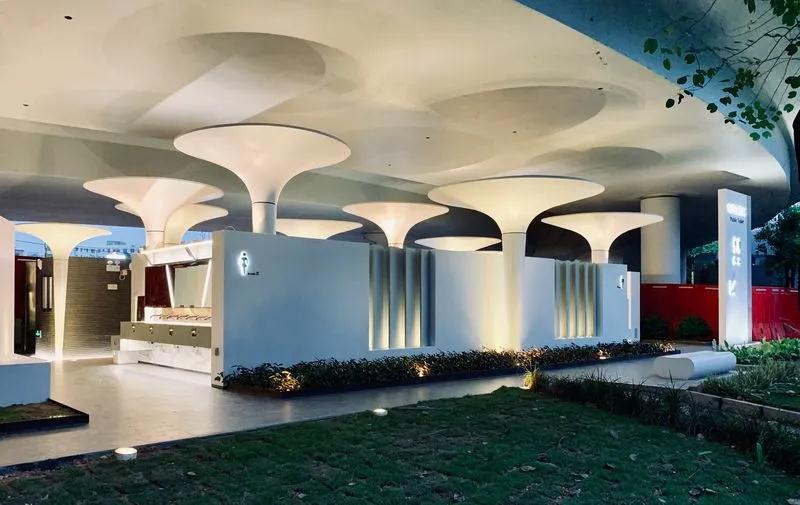The beauty of Shenzhen's public toilets
During the early days of China's reform and opening up, one major concern that attracted many complaints from foreign visitors was the poor state of public washrooms: dirty, smelly, unhygienic, and perhaps worst of all, lack of privacy protection. Not to mention rural areas' "open-pit latrines," which were breeding grounds for maggots and fecal-oral diseases.
Shenzhen, the cradle of China's reform and opening up, at that time did not fare any better than other mainland cities in terms of public sanitation. A file photo shows three foreigners visit a public toilet on Renmin North Road in 1979, the year when Shenzhen City was established. The facility in the photo was a typical public toilet in urban China for decades, walled but unhygienic, filthy, crude, and anxiety-inducing as the cubicles had no doors.

Foreigners visit a public toilet on Renmin North Road in Luohu District in 1979. File photos
China launched a "toilet revolution" in 2015 to increase the numbers and improve the sanitation of toilets at tourist sites, and it was later expanded to improve public toilets in cities and build better ones in the countryside. With hefty investments from the central and local governments, the campaign has greatly transformed basic sanitation services across the country.
In the past three years, Shenzhen has built 374 new public washrooms and renovated nearly 3,000 old ones, according to the city urban administration.

A view of a public washroom on top of Lianhua Hill in Futian District in 2020.
Shenzhen's "toilet revolution" is not aimed at simply bringing access to basic public sanitation. As a pioneering city, Shenzhen has brought the "toilet revolution" to a new level – many of these newly built or renovated public toilets not only are equipped with brand-new, clean and hygienic utensils, but also feature aesthetic designs and smart facilities.
Shenzhen is serious in this "revolution." In 2017 the municipal urban administration published a guide on the construction and renovation of public toilets, totaling 66 pages, with all the details you could imagine. When it comes to the renovation of existing washrooms, the renovation plans are required to pass the review of experts before work is permitted to start, ensuring the quality of these projects reaches required standards.

The entrance of the Qianniuhua (the morning glory flowers in English) public restroom, named after the flower for its morning glory-shaped colomns, at Shuanglong Metro Station of Metro Line 3.
Shenzhen's "toilet revolution" not only demonstrates the city's technology prowess and its modernity, but also reflects its people-centered approach.
To help taxi drivers, delivery riders and couriers answer nature's call conveniently, 100 small public toilets have been built at street corners, greenbelts and community parks. Although small in size, these toilets have air conditioning, WiFi, charging ports, hand dryers, fragrance diffusers, baby diaper changing stations and various automatic utensils, and are accessible by physically challenged people.
Women's needs also factor in. As statistics showed women's restrooms should be at least 50 percent larger than men's, more female toilet cubicles were added. The newly built washroom on the top of Lianhua Hill has 16 male cubicles and urinals, as compared to 25 cubicles for women. Many public washrooms now have nursing rooms and baby diaper changing stations. Handrails, hooks and racks can be seen inside the cubicles. Some large washrooms also have "the third toilet," set up for people with relatives (especially the opposite sex) who cannot take care of themselves, such as a mother assisting her son.
Many new public washrooms in Shenzhen, which have broken the stereotype of public toilets, have taken the internet by storm with their appealing designs and modern facilities. They remain practical and down-to-earth without useless vanity features. In some parts of the country, the "toilet revolution" went a bit too far, with some of the most extravagant examples including LED televisions, refrigerators, microwave ovens and facial recognition systems meant to prevent toilet paper theft.
Modern, well-equipped public restrooms can become filthy and smelly if not properly maintained. Since 2018, Shenzhen has released a public toilet environment index each month, ranking the management of public restrooms in the city's 74 subdistricts and 16 industries. The ranking and inspections that come with it have helped ensure that public washrooms are well maintained.
However, the city needs to educate the public on bathroom etiquette and civility at large. Occasionally washroom users are disgusted by unflushed toilets or spilled urine. Some taxi drivers can be seen relieving themselves on the roadside, flabbergasting anyone who is unlucky enough to witness the scene.
For men standing in front of urinals, a reminder sign posted on some restrooms saying "A small step forward, a giant step for civility" is quite to the point.
Only when bathroom etiquette is improved and public restrooms are well maintained, can we take pride in these well-built washrooms as Shenzhen's new attraction.
(The author is a deputy editor-in-chief of Shenzhen Daily.)